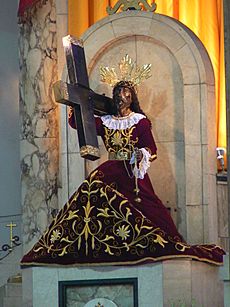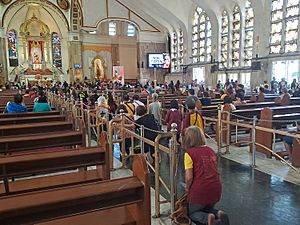Black Nazarene facts for kids
Quick facts for kids The Black NazareneNuestro Padre Jesús Nazareno Poóng Itím na Nazareno |
|
|---|---|
 |
|
| Location | Quiapo, Manila, Philippines |
| Date | 1606 Acapulco, Guerrero, Mexico |
| Witness | Recollect Priests Archbishop of Manila, Basílio Sancho de Santa Justa y Rufina |
| Type | Wood carving |
| Approval | Pope Innocent X Pope Pius VII Pope John Paul II |
| Shrine | Minor Basilica and Archdiocesan Shrine of the Black Nazarene |
| Patronage | Quiapo, Manila, Filipino peoples, Philippines |
| Attributes | Dark skin, maroon and gold vestments, the Cross |
| Feast day |
|
The Black Nazarene (Spanish: El Nazareno Negro; Filipino: Poóng Itím na Nazareno) is a famous statue of Jesus Christ in the Philippines. It shows Jesus with dark skin, kneeling and carrying a large cross. This life-sized image is kept in the Minor Basilica of the Black Nazarene in Quiapo, Manila.
Many people believe that touching the statue can bring miracles or heal illnesses. The original statue, or a copy of it, is part of a religious parade three times a year:
- January 9 — This is the main Feast of the Black Nazarene. It celebrates when the statue was moved from Intramuros.
- Good Friday — This day remembers the suffering of Jesus.
- December 31 — This parade happens on New Year's Eve. It starts a special nine-day prayer period called a novena.
Contents
What is the Black Nazarene?
The statue is called "Nazarene" because it refers to Jesus Christ from Nazareth. Its dark color is special, as many other statues of Jesus have lighter skin.
Parts of the Statue
The statue stands on a wooden base called a peana. During parades, it is placed on a special carriage called an ándas. This carriage helps move the statue forward.
The Original and Its Copies
There isn't just one Black Nazarene statue. There are several copies used for different events.
- The Vicário is a copy used for the big annual parade called the Traslación. It is also used for the New Year's Eve and Good Friday parades.
- The head of the original Black Nazarene is on the statue kept at the main altar of the church. Its body is made from Molave wood.
- The original right hand of the statue is kept by the parish priest. It is used to bless people, especially those who are sick or dying.
- The Vicário statue has the original body, but its head is a copy made from Batikulíng wood.
Other Copies
The church also has three other copies of the statue called Callejeros. These copies travel to different Catholic churches across the country. They visit places where people want to see and pray with the Black Nazarene.
History of the Statue

An unknown Mexican artist carved the Black Nazarene statue. It arrived in Manila from Acapulco, Mexico, on May 31, 1606, by a large ship called a galleon.
Some people believe the statue's dark color comes from soot from candles burned near it. A popular story says it turned dark because of a fire on the ship that brought it from Mexico.
However, a researcher named Monsignor Sabino Vengco said the statue was not burned. He believes it was carved from dark mesquite wood, which was common in Mexico at that time. He found this out during his research in Mexico.
The statue was first placed in a church in Bagumbayan. In 1608, it was moved to the Recoletos Church inside Intramuros. The church and the statue were destroyed during the Battle of Manila in 1945.
What the Statue Looks Like
The Black Nazarene wears a braided wig made of dark fiber. It also has a golden Crown of Thorns. Attached to the crown are three golden rays, called "Tres Potencias" (three powers). These rays show that Jesus is divine. The original statue has lost some fingers over many years.
Jesus is shown barefoot and kneeling. This posture shows the pain and heavy weight of the cross he carried. The cross itself is made of black wood with brass caps.
The Clothes of the Statue
The statue always wears a thick velvet tunic that is maroon in color. It has gold designs of flowers and plants, with white lace on the collar and cuffs. Around its waist is a gold belt with the word "NAZARENO" on it. A golden chain is around its neck and held in its left hand.
The statue's clothes are changed in a special ceremony called Pabihis. A Catholic priest leads this event. People watch inside the church or outside in Plaza Miranda. During the ceremony, a curtain is raised to hide the statue while male helpers change its clothes. After the change, the old clothes are given to the faithful. People line up to touch and kiss these old clothes, believing they have special powers from the statue. This clothing change happens five times a year for important religious events.
Church Approvals
- In 1650, Pope Innocent X approved the worship of the Black Nazarene. He allowed a group called the Confraternity of the Most Holy Jesus Nazarene to be formed. This group was for regular people, as Filipinos were not allowed to become priests during the Spanish Era.
- In 1880, Pope Pius VII gave the statue his special blessing. This meant that people who prayed sincerely before the statue could receive a special spiritual gift.
- On December 11, 1987, Pope John Paul II declared the church a Minor Basilica. This was a special honor for the church.
Devotion to the Black Nazarene
Many Filipinos feel a strong connection to the Black Nazarene. They see their own struggles and difficulties reflected in the suffering of Jesus shown in the statue.
Some believers walk barefoot as a sign of their faith. Others try to get on the carriage during parades, hoping to receive blessings. Before the 1960s, the parades were calm. But as more people joined, they became very large and lively.
Even though the church's main patron saint is John the Baptist, the Black Nazarene and its big parade, the Traslación, are much more popular.
After each church service, people clap their hands to show respect for the statue. Besides the parades and special prayers, lighting candles is another popular way to show devotion. Also, many people crawl on their knees down the main aisle of the church towards the altar and the statue.
Every Friday (except Good Friday) is known as "Quiapo Day" in Metro Manila. This is because special prayers for the statue are held on this day across the country. This day often causes a lot of traffic around the church because so many people visit.
The school next to the church, Nazarene Catholic School, also shows this devotion. Its newsletter is called "The Nazarene," and students are called "Nazareñans."
The biggest annual parade for the Black Nazarene is the January 9 Traslación. Millions of Catholic devotees attend, trying to touch the statue or have their towels wiped on it. They believe this brings blessings and power. The Black Nazarene is one of the most popular religious images in the Philippines, along with the Child Jesus. In 2011, over six million people attended the Feast of the Black Nazarene.
Music for the Nazarene
The song Nuestro Padre Jesús Nazareno was written by National Artist of the Philippines, Lucio San Pedro. It is the official song for the statue and its events.
The Black Nazarene is also often shown on the cover of Pabasa books. These books contain hymns used during Lent to remember the life and suffering of Jesus Christ.
Different Views on the Devotion
Some people have different ideas about the devotion to the Black Nazarene.
- Jaime Laya believes that the way people worship the statue is a modern form of an old Filipino practice. He suggests it might be linked to ancient customs where Filipinos would physically touch sacred objects. Elizabeth Pisares also thinks it's a revised old practice and connects it to social differences among Filipinos.
- However, Father José Clemente Ignacio, the head priest of the church, says the devotion is not about worshipping the statue itself. He explains it's a Filipino cultural trait to want to touch or embrace sacred things. He believes it shows faith in "the presence of the Divine in sacred objects and places."
- Mariano Barbato notes that the discussion about the statue comes down to how people understand what religious devotion means. It's about different ways of thinking about how a religious image is seen and what makes a procession meaningful.
See also
 In Spanish: Cristo Negro (Manila) para niños
In Spanish: Cristo Negro (Manila) para niños
- Feast of the Black Nazarene
- Black Madonna
- List of statues of Jesus



